One of the great things about HubSpot is the fact that it has so many amazing features and capabilities for people to make the most of. While this is an evident benefit, it can also make people feel a bit at a loss too! There are so many business owners out there who are failing to leverage everything that HubSpot has to offer because they have not researched the platform or engaged in training. There is no need to worry, though, as we have you covered. In this guide, we are going to focus on HubSpot Contacts specifically. Continue reading to find out everything you need to know.

Table of Contents
- What is your HubSpot contacts database?
- Why Contacts?
- Important steps to take
- Contact Activity Feed
- Use integrations to collect contacts Automatically
- Integrations - e.g Email, & Website Forms
- Using contact settings
- What are the best practices for contact management?
- What are lists?
- How to create a list of all your HubSpot contacts
- Creating static or active lists
- What are you able to do with lists?
- Putting this all into action
What is your HubSpot contacts database?
Your contacts database is of huge importance because it is central to all parts of your company. When it comes to those using HubSpot, this means that it is central to all parts of your account on HubSpot. You will be able to use it so that you can keep track of each and every person that has a relationship with your company. You will be able to interact with them and you will be able to do so in the most beneficial and fruitful manner because you can personalise these interactions. This is beneficial no matter whether you have a database of 10 contacts or 10,000. After all, understanding your contacts and your relationship with them is imperative if you are to boost loyalty and engagement. Therefore, it is extremely important that you fully understand HubSpot Contacts and what this can do for you.
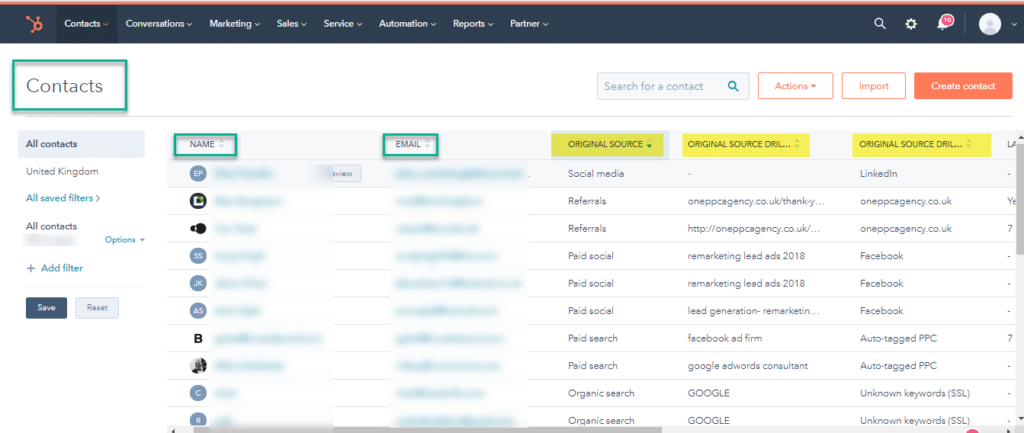
Why Contacts?
A contact is an individual that your company engages, partners, sells, or markets too. It also includes anyone that your company employees. As you continue to educate and inspire your contacts, they will tell your story and you can build up a strong brand image and increase your sales levels. Contacts should not be viewed as names or email addresses. They are individuals that you are going to be building relationships with.
Contacts are at the heart of your sales and marketing strategy. Both of these sides are working together to the same goal, which is why effective collaboration is of huge importance. Both departments want to take strangers and ultimately transform them into consumers.
Both of your marketing and sales teams need to be involved in your contract strategy. However, having two different departments involved in the same thing can be confusing if you do not have a good system in place. This is where your contacts database comes into play. This creates consistency and alignment with all of the contracts you are interacting with as part of your inbound strategy
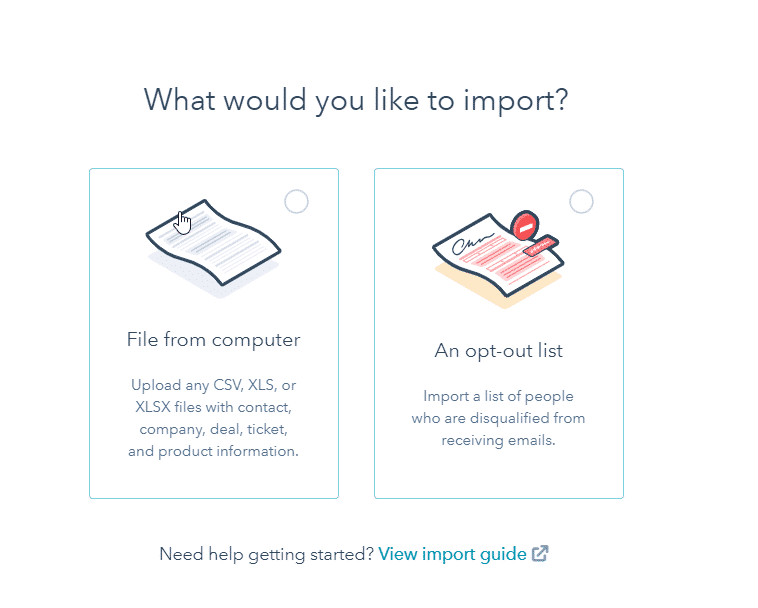
Important steps to take
When it comes to creating this alignment and ensuring everyone is on the same page, there are a number of important steps you need to take. These are as follows:
- You must update your contacts in your database so that you can keep it clean and organised. This is something that both your sales and marketing teams should be participating in.
- Create segmented lists and filters to reach the right people, in the right context and time.
- Manage and discuss the lifecycle stages to make sure that they are consistent.
Contact Activity Feed
The contact activity feed is like the wall on Facebook. It give you a summary list of your contact activity. The types of activities include email opens, email clicks, send emails, lead visits , prospect visits, document views, meetings, forms
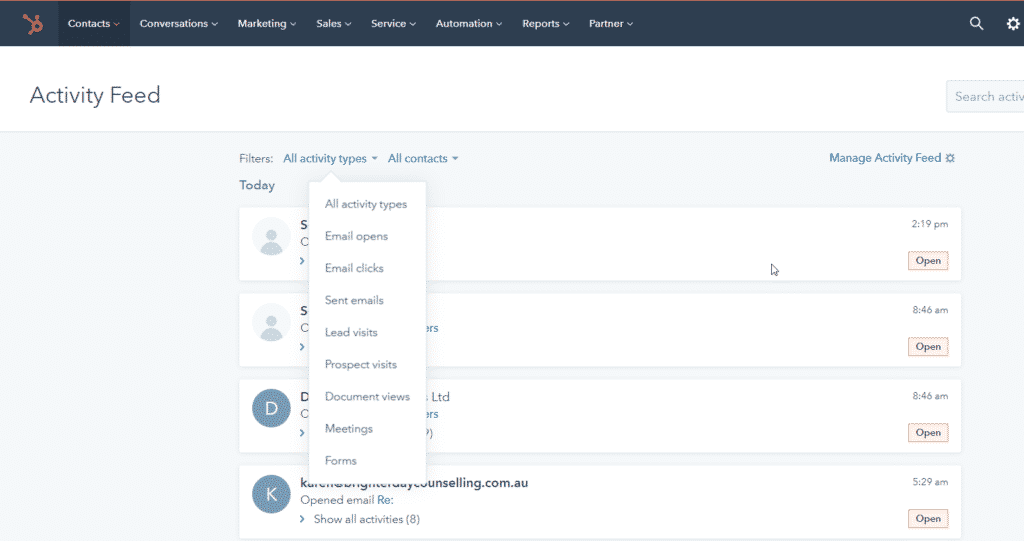

Use integrations to collect contacts Automatically
You can link various third party systems with Hubspot including email like Gmail and Outlook. If contact from your email system is not yet a contact, HubSpot will create a new record for this. If it is also a company domain URL, HubSpot will add the contact to an existing company record, or create a new company record if it is not already in your CRM. Hubspot auto populates many of the company record properties such as company phone, website and social pages.
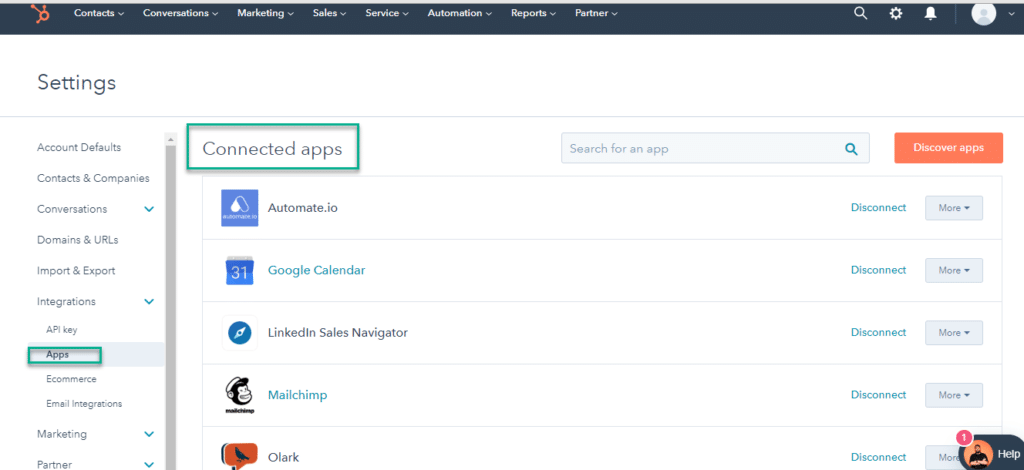
Integrations - e.g Email, & Website Forms
Linking emails to HubSpot automatically creates new contacts within HubSpot. Email integration also gives a shared team inbox. WordPress has its own integation with Hubspot

Using contact settings
The settings in HubSpot let you modify the contact card properties. Properties are the “variables” or fields which can be updated for each contact. Examples include phone number, email address, name, traffic source and more. You can also create custom properties unique to your industry and company.
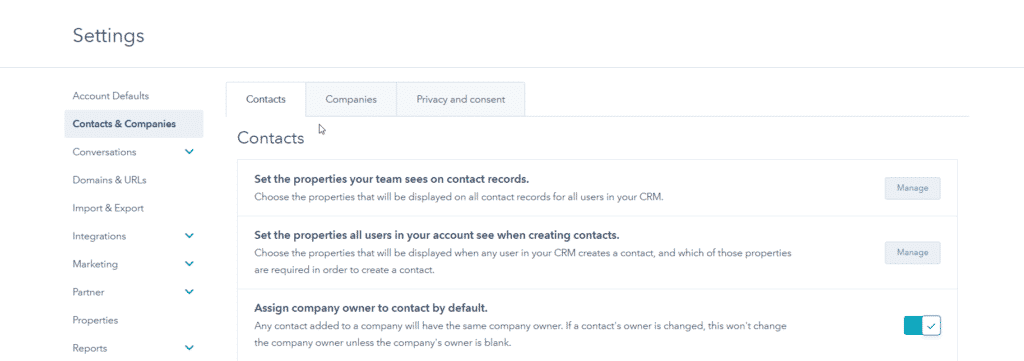
The contact settings also has tracking options to monitor contacts and nurture them into leads , deals and prospects.
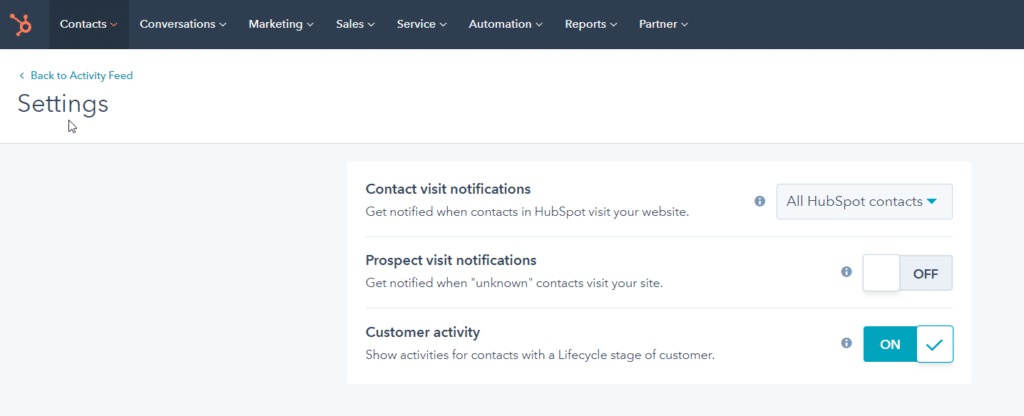
What are the best practices for contact management?
- Make sure you keep your database organised and up-to-date – The first and most important step is to ensure your contact database is clean and organised. Your contacts database is going to decay by about 20 to 30 per cent throughout a year. Because of this, you need to ensure that you regularly delete or update your contacts to ensure you have the most usable and accurate information about them.
- Create segmented lists – Aside from keeping your database organised and up-to-date, you should make the most of segmented lists. You can start to segment your contacts once the are recorded within your contacts database, and ongoing over time If you know that some of your contacts want to work on a specific area, for example, blogging, then you could create a segmented list for this, using filters based on this information. This ensures that contacts that are similar can be brought together so that your sales teams and marketing teams can create specific actions for them to increase the success of your efforts.

HubSpot is one of the most popular software solutions out there for businesses today. Offering everything from CRM and customer service to sales and marketing; it is not hard to see why so many professionals and businesses are making the most of this solution. However, if you are to leverage the full capability and optimise your use of HubSpot, you need to make sure that all of your employees know how to utilise it to full effect. With that being said, in this blog post, we are going to take a look a HubSpot lists specifically. Read on to discover everything you need to know about creating lists on HubSpot.
What are lists?
Lists play a critical role in marketing. Not only do they help you when it comes to sending out emails but they also give you the ability to identify how many of your database contacts have specific traits in common. Furthermore, if you use lists to create reports, you are going to make the Lists App in HubSpot even more powerful, meaning you can truly leverage the use of it.
How to create a list of all your HubSpot contacts
One of the basic yet highly beneficial things that you are able to do is create a list of all of your HubSpot contacts. This can be beneficial for the customer service and marketing segments of your business. It is really easy to do asl well. Plus, you can use a contact property to segment your lists.
So, what steps should you follow in order to create a list of your contacts on HubSpot?
- Head to the ‘Contacts’ section of your HubSpot account.
- Click on Lists.
- You should then select Create list.
- Once you are here, you will notice a pencil icon in the top left. You can click on this and create a name for the list.
- There is then a dropdown menu in the upper left of the dashboard. You should select this and choose whether you want a Static or Active list. We will explain more about both more options in this guide.
- You can then head to the Filters section. Here, you will be able to segment your list. You can do this by choosing Contact property and then creating a date. Select is known.
- Click done.
Creating static or active lists
There are two different types of lists that you can make the most of on HubSpot. We just mentioned them in the section above: active and static lists. You may be wondering what the difference between the two is so that you can determine what sort of list is going to be right for you. So, let’s take a look at both options…
- Active lists – With an active list, this will update automatically, based on its criteria. Whenever a contact meets the criteria that you have set, it will join the list without you having to do anything. Equally, if a contact no longer meets the list of criteria, it will be removed from the list. A good example of when an active list is suitable is if you are creating an email campaign that is only designed for a specific subset of your contacts over a period of time. This makes sure that the list you are sending to the email campaign is always up-to-date with contacts that are suitable for the emails you are going to be sending out.
- Static lists – While active lists update automatically, static lists do not update at all. It is up to you to make manual amendments if you need to do so. If a contact meets the criteria of your list, they are not going to be added to it automatically. Therefore, a static list becomes a snapshot of all of the people that meet your specific set of requirements at that one point in time. Contacts must be removed or added manually. Therefore, static lists are useful when you are looking for contacts that met your requirements at a certain date.
What are you able to do with lists?
There are a number of different things that you can do with lists in HubSpot. Let’s take a look at some of the most beneficial features of HubSpot lists in further depth.
- Build a list off a contacts property – Firstly, you are able to build a list off of any contracts property in your database. This is something that we discussed earlier when we spoke about how to create a list on StubHub. This means you can create lists based on a number of different factors, for example, you could create a list of all of your contracts that came from social media.
- Build a list off a company property – Not only are you able to create a list using property in regards to your contracts, but also any company properties too. These fields will give details about the business as a whole, rather than focusing on individual contacts. Some examples of this include the likes of annual revenue, industry, and website URL too.
- Build a list off a deal property – A deal property relates to the amount of revenue that you are pulling in from your CRM. Therefore, you will also be able to use this in order to create effective lists too.
These are three of the most common options people go for in terms of building their lists. However, there are plenty of other ways you can go about it. For example, you can build a list off an integration action, workflow, event, page views, email actions, form submission, and list membership too.
Hopefully, you now have a better understanding of HubSpot lists and what you are able to do with this feature of the software. There are many different types of lists that you can create and use on HubSpot. This guide has given you a basic overview of some of the most useful and effective lists to make the most of.
Putting this all into action
The final piece of the puzzle is to execute all of this. There is no integration or sync between marketing and sales contacts in the HubSpot contacts tool. It is one database, which provides your team with the most visibility and value into where your relationships are flourishing with your contacts, enabling you to continue to put the best practices into a place. This ensures that all of the relevant teams have access to the contacts needed, so it’s more efficient and effective, so long as everyone stays on top of contact management. It is important to remember that discussing lifecycle stages, creating segmented lists, and keeping everything clean is pivotal, as there is a lot that goes into maintaining a contacts database and ensuring alignment across your teams. On the surface, this can seem like a trivial or pointless process, or even a waste of time, but when you think about just how important your contacts are to the success of your business, then you see why this is something that simply cannot be overlooked.
So there you have it: everything you need to know about HubSpot Contacts. We hope that this has given you a better understanding of this part of the software and how you can leverage it to ensure that you are using HubSpot to full capacity and maintaining and improving your relationships. After all, your contacts are at the heart of your business and knowing how to manage them effectively can either make or break your company.
To work with an expert HubSpot Partner Agency, check out our sister company Inbound Scaling










